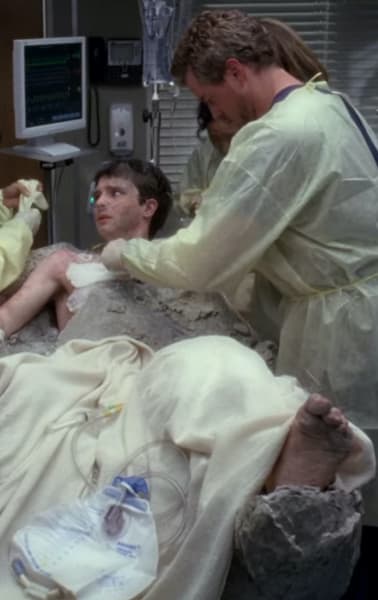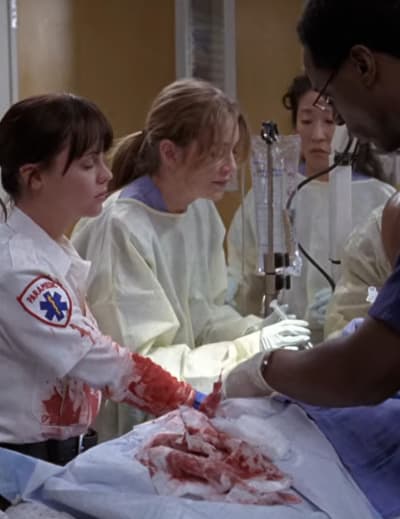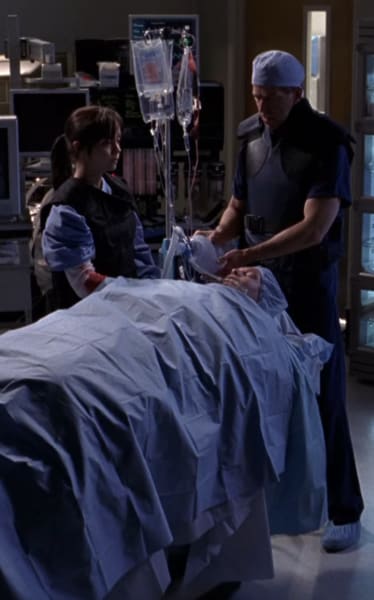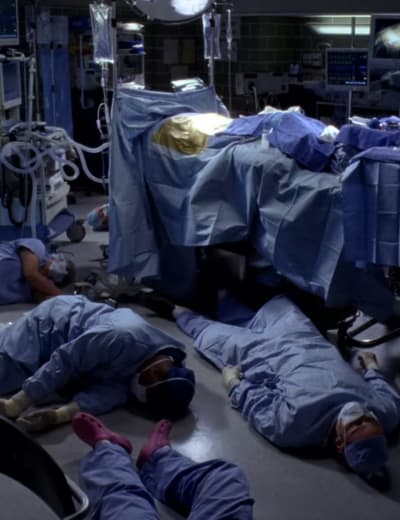There are many episodes to pick from when discussing the most surprising medical cases aired on Grey’s Anatomy since its debut in 2005.
The fact that they can still even shock the audience after all this time is a testament to the writers, producers, and cast.
Even if these cases aren’t dealt with at your local hospital or have happened more than once, the scariest part may be that they are generally based on real-world people and events.

Whether they are ranked for their rarity, uneasiness, or gore, here are some of the strangest medical cases that will leave you puzzled, make your skin crawl, and make you think twice about what dares you agree to.
Man Whose HPV Warts Resembled Wood

One of the most unusual medical cases occurred on Grey’s Anatomy Season 7 Episode 3.
A man came to Grey-Sloan Memorial Hospital with hands resembling tree branches and warts that seemed more wood-like than human.
This debilitating condition, unfortunately, left the real man from rural Indonesia unable to do everyday tasks like pick up silverware or make a fist.
He made a living by performing in carnivals and was sent to live in isolated villages in Indonesia.
In real life, similar to the show, his condition stemmed from contracting HPV along with having an immune defect.

The growths covered his body, accounting for almost 12 pounds of his 100-pound body. Like in the episode, he also had insects living in the warts.
Due to his deficiency of white blood cells, his immune system could not fight the HPV.
The virus took over his skin cells, producing excessive keratin, which then turned to growths called “cutaneous horns.”
He went untreated for 20 years, and the lack of an industrialized country’s health care system that would have intervened before it got to this point contributed to why it developed into a case this bad.
It was a miracle he even survived this long, but his supportive family sought his survival. After his case garnered attention, a doctor performed numerous surgeries to remove the warts.

Although the warts reappear, he receives chemotherapy for the virus and can do things he couldn’t before, like walk, use silverware, and write.
Woman With Worms In Her Stomach
Ascarius lumbricoides is the most common parasitic worm found in humans, although rare in the US, and is on full display in Grey’s Anatomy Season 13 Episode 21.
The patient, Mary, comes in with abdominal pain and ends up throwing up on April. Shortly after, April feels something in her hair and discovers it is a worm.
Mary’s scans reveal she has intestinal roundworms and requires surgery.

Intestinal roundworms are found in areas of poor sanitation and can be associated with anemia and malnutrition, impairing growth and cognition.
The Boy Stuck In Cement
In Grey’s Anatomy Season 4 Episode 16, Andrew Langston is sent to the hospital after accepting a dare to sit in a vat of cement, which causes severe burns and dehydration.
The team of doctors was concerned about numerous things going wrong if they didn’t operate soon, including loss of limbs, liver failure, toxin build-up, and heart failure.

While finding evidence of this in real life is scarce and, more often than not, is localized rather than the whole body, there is science behind the concerns discussed in the show.
Coming in contact with cement for hours can cause all of those things, as was evident in a man who jumped into a cement mixer and was found three hours later.
He had extensive burns, hypothermia, and metal toxicity from intestinal and skin absorption. Eventually, his liver and kidneys started to fail.
Man With Tree Growing In His Lungs
Raul Aranda was a patient in Grey’s Anatomy Season 7 who came in coughing up blood and thought it could be from cancer.

Instead, it was a tree growing in his lung that required surgery to remove it. It is suspected he inhaled a seed.
This can’t be real. Despite all our instincts to say no, it did happen.
A Massachusetts man also thought he probably had cancer. After going to the hospital, X-rays revealed a pea plant growing about half an inch tall in his lungs.
Women with Spontaneous Organisms
In Grey’s Anatomy Season 2 Episode 18, Pamela Calva was admitted to the ER because of a minor car accident caused by a random orgasm, something she had been experiencing for a few months.

While it wasn’t directly explained in the episode, Krista Vernoff wrote on her blog that they were caused by a small tumor on her pudendal artery that constantly caused stimulation.
In reality, Persistent Genital Arousal Disorder (PGAD) was only discovered and named in 2001, and very little is known about the disorder.
The rare condition is characterized by unwanted genital arousal even when there’s no reason for it, and people do suffer from the disorder.
It’s hard to say the exact number of people it affects, but it’s guessed that around 1% of people assigned female at birth suffer from it.
Man With Bomb In His Chest

On Grey’s Anatomy Season 2 Episode 16, James Carlson and his friend decided one day to recreate a WWII bazooka, and when it didn’t work, he went in front of it to check it out when it fired a shell into his chest.
It was a frightening experience that was successfully removed from James but unfortunately killed bomb squad personnel, Dylan, while carrying it out.
While extremely rare, it has happened more than you would think, but it almost exclusively happens to military personnel and is described as a military injury.
According to a 1999 study of 36 instances where this happened during WWII, 18 were caused by M79 grenade launchers. However, there have been a few instances of this happening to people not in the military.

Out of those 36 known cases, surprisingly, there were only four fatalities, and all four died before surgery could have even been attempted.
Girl Who Couldn’t Feel Pain
On Grey’s Anatomy Season 3 Episode 3, Megan Clover comes to the hospital with a gash on her leg and a cut on her arm that she stapled shut herself.
She then pulls them out herself with no reaction, and after Karev runs tests, he realizes she has congenital insensitivity to pain with anhidrosis (CIPA).

CIPA is a real and extremely rare disorder that causes people not to feel pain because the pain-receiving nerves in their brains are not correctly connected.
The odds of having CIPA are 1 in 125 people, and while the majority don’t live over the age of 25, they can live long lives with the correct care that involves constantly checking for internal and external injuries.
The Woman With Toxic Blood
On Grey’s Anatomy Season 3 Episode 14, Marina Wagner was a patient who recently had a tumor removed from her colon and believed she was in remission until she woke up barely breathing.
When George O’Malley was drawing her blood, he started shaking but didn’t think much of it until Olivia Harper and a lab tech ended up in the clinic with him.

George O’Malley realized that the patient’s blood had become toxic due to her chemo drugs and an herbal supplement she was taking. When he went to call the OR and warn them, it was too late. They had already passed out.
Thinking there was no way a real case like this could exist, it was shocking, to say the least, when I read about a woman from Riverside, CA.
In 1994, the woman went to the ER because she had late-stage cervical cancer, was experiencing heart palpitations, and seemed very confused.
When the hospital staff realized she wasn’t responding to the meds they administered to her, the next step was to defibrillate her heart.

At that point, they noticed her body was covered in an oily sheen and had a fruity, garlic odor they assumed was coming from her mouth. When a nurse drew her blood, she noticed an ammonia-like smell.
When the nurse handed the tube of blood to a resident, the nurse fainted, and soon after, the resident also fainted, along with the respiratory therapist who was helping them in the ER.
A total of 23 people became ill, with five hospitalized.
Unfortunately, she passed away from kidney failure that stemmed from her cancer. Which means no one could confirm the theory behind her toxic blood.

However, an investigation that followed suggested she had been self-administering dimethyl sulfoxide (DMSO), a chemical she used to treat her cancer-related pain.
She had covered her body in it. Why? Well, in the ’60s, people believed that it was a cure-all.
Later, that was proven false, but the idea still had an underground following.
The problem is when DMSO is exposed to oxygen, it becomes dimethyl sulfate. The chemical’s vapors can cause convulsions, delirium, and paralysis.

Of the 20 symptoms reported amongst the medical staff, 19 matched those of exposure to dimethyl sulfate vapors.
Although it can’t be 100% confirmed, the case has been looked at by forensic scientists, chemists, and toxicologists, and it is the most scientific explanation known to date, and no other theories have been made.
Girl Who Could Hear Her Internal Organs
In Grey’s Anatomy Season 6 Episode 22, Demi Lovato played a patient who attempted to claw out her own eyes and claimed to hear her internal organs.

At first, the staff thought she was a paranoid schizophrenic, but she actually had an affliction called superior canal dehiscence syndrome (SCDS).
SCDS is caused by a hole in the bone covering part of the inner ear. This hole leads to distorted hearing and impaired balance.
Little is known about the prevalence of SCDS, but some cases give insight.
One man who suffered from SCDS said he could hear his eyes moving in their sockets, and it sounded like scratching sandpaper.

One frightening symptom is autophony, or “hearing one’s self.” Sounds from inside the body, such as breathing, blood flow, heartbeat, and even eye muscle movement, can be heard because of the abnormal opening.
Man Who Watched Porn As a Pain Killer
When the residents do rounds, they never thought that walking into a man’s room, where his wife is knitting, would give way to the situation they found themselves in during Grey’s Anatomy Season 2 Episode 5.
Henry is receiving a spinal implant from Derek Shepard. Because he is allergic to pain meds, a former doctor recommended watching porn to help manage pain because it causes his brain to release endorphins.

Spinal implant surgery has an excruciating recovery, and he cannot take painkillers, so the solution plays on his TV.
How often is this applied in real life? It doesn’t seem very frequently. Trying to find actual cases, understandably, leads to articles discussing the problems of porn addiction.
However, it does make sense, but for the most part, only in men. It releases endorphins, and anything that splits the sensory processing or input delivery can block pain or at least distract from it.
Theoretically, it is a biological and psychological mechanism that can be employed to shape behavior and thought.

Part of Grey’s Anatomy’s appeal is that you never really know what will walk through Grey Sloan Memorial Hospital’s door.
Shonda Rhimes can brilliantly mirror what is going on in the lives of the doctors with the most unique medical cases ever heard of.
Considering there is no end in sight for the series, there will surely be more bizarre medical cases and captivating doctor drama. We cannot wait to see what else is in store for us.
We would love to know which case you won’t be able to forget, which you were most intrigued by, or which you still can’t believe is real. Let us know in the comments below!
Edit Delete
Eve Pierpont is a staff writer for TV Fanatic. You can follow her on X.







